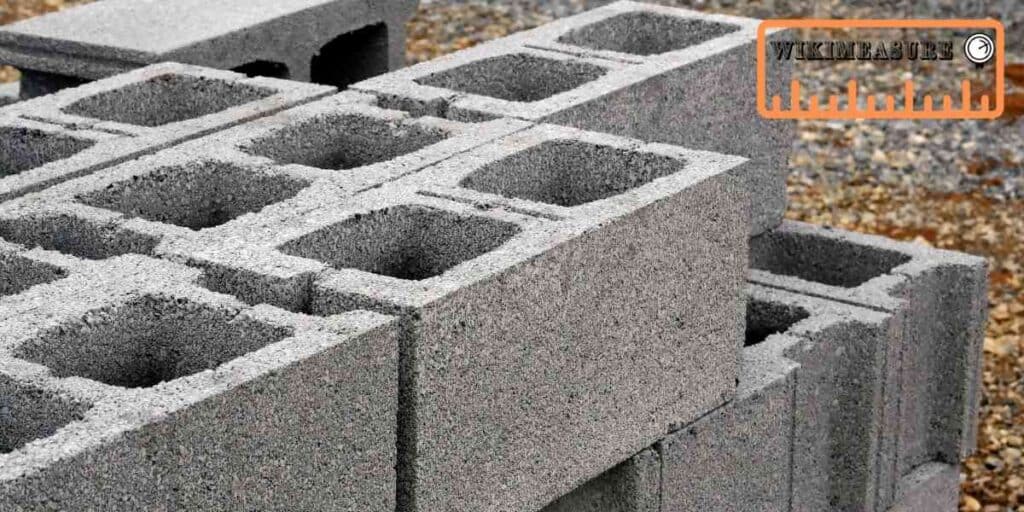How much does a concrete block weigh? A standard 8 inch by 8 inch by 16 inch hollow concrete block weighs 38lbs (pounds) or 17.24 kilogram (kg).
How Much Does A Concrete Block Weigh
What Is Concrete Block?
Concrete blocks are made using three primary ingredients: Portland cement, aggregate (usually sand), and water. Various additives are also often used to change the properties of the finished product.
The first step in making concrete blocks is to make a dry mix of Portland cement and aggregate (usually sand plus gravel). The ratio of cement to aggregate is generally about 1.5:1.
The water/cement ratio can vary somewhat because the mix has an internal water limit of about 0.35%, which is reached when the blocks are dry enough to pass a 4-inch slump test, or 1/4″ x 4″, where the block crumbles easily when lifted with a spade.
This mix is then placed into a tower for molding. The tower usually has two components, a mixer barrel and a block molding machine, which forms the finished blocks out of the mix. The blocks are typically 25 cubic feet each, the equivalent of a 4′ x 4′ x 8″ cube or similar size.
How Do You Calculate The Weight Of A Concrete Block?
The weight of a concrete block can vary considerably. It is about four thousand pounds per cubic meter, depending on the density of the type of concrete used. The weight of a concrete block will also vary depending on the size of the block being weighed.
If you are looking to find out the weight of a concrete block, you would first need to find out what type of concrete was used in its construction. You can do this by checking the label on the concrete block. If you are unsure, try to find out by asking someone who may know.
Once you have found out the weight of a concrete block, you will need to find out what size it is. Concrete blocks can vary in sizes from very small, which may be the size of a brick, to much larger sizes. Once you know what size it is, you can find out the weight by using a calculator.
Calculating the weight of a concrete block is easy once you have both of these pieces of information. All you need to do is find out what the weight of a cubic meter of concrete is. Once you have this information, multiply it by how many cubic meters are in the concrete block. This will give you the weight of the concrete block.
What Is The Difference Between A Cinder Block And A Concrete Block?
Cinder blocks and concrete blocks are very similar. They both can be used for outdoor structures like patios and garden paths, but cinder blocks are more porous. Cinder blocks are often used for fencing and garden walls, as well as paving.
Block is a general term for any rectangular building unit similar in shape to, but smaller than, a brick. A cinder block is one of many similar concrete masonry units, manufactured off-site with a rectangular shape and hollow interior.
A concrete block is manufactured on-site. A concrete block is sometimes called a solid masonry unit (or brick). A concrete block is made of sand, gravel, and Portland cement, while a cinder block is made of similar material but with a much lower cement content. A cinder block, therefore, is more porous than a standard concrete masonry unit of comparable size.
Both are made of concrete, so they have similar properties of being relatively inexpensive and easy to use. They are both commonly used as building blocks as the strength of a cinder block is usually similar to that of a concrete masonry unit of equivalent thickness.
Both are called CMU blocks in general. The main difference between cinder blocks and concrete blocks is the size of pieces used to make them. A concrete block is made with pieces that are neat cemented together, while cinder blocks use random pieces of aggregate that are burned in a kiln at high temperature, then cemented together with very little compaction of mortar joints.
The difference is that cinder blocks are made of cement and aggregate that is less refined than poured concrete. A cinder block is typically made of porous, unglazed concrete with hollow air-filled cavities that are filled with burnt coal or cinders.
A cinder block is a type of masonry unit composed of industrial waste such as cinders or ashes mixed with a binding material such as cement. A cinder block is typically made of porous, unglazed concrete with hollow air-filled cavities that are filled with burnt coal or cinders.
Here’s the differences between cinder and cement blocks.
Uses Of Concrete Blocks
Concrete blocks are used in construction of buildings, homes, highways, bridges and dams. They are also used for making partition walls. A concrete block is a rectangular shaped building material which is made from cement and sand, water and gravel. The finished product always has a rough surface because it is ready to be covered with plaster or smooth wall-paper.
Concrete blocks are manufactured in molds, each mold having a number of cavities, each cavity producing a block which is a perfect cube. The molds for concrete blocks are made of either wood or metal, depending on the design of block to be manufactured. A typical mold comprises two pieces, one being a female piece and the other being called a head board.
The head board is mounted on a spindle which is connected to a screw, the rotary motion of which turns the mold.
As soon as the cement, sand and water mixture is put into the mold cavity and the screw of the head board starts rotating, it forces the concrete block out of the female piece of the mold and at the same time it compresses the block between itself and the head board. Another method of pressing concrete blocks is by means of a number of individual pneumatic pistons, each connected to its own mold.
As soon as the required pressure is applied to the piston, it forces the block out of its cavity, thus compressing it. The compressed blocks are then dried in a drying chamber that is heated. The wooden molds are treated to prevent the blocks from sticking and this is done by coating them with a special preservative.
They provide a structurally sound and fireproof wall or partition. They support the floors, roof and chimney of a building or home. They are ideal for retainer walls in the construction of roads, bridges, and dams. They provide strong, durable, and economical structures for large buildings.
Concrete blocks save the material that would otherwise be used to make bricks or stone for construction purposes. They provide a long life and resistance to fire and weathering. They also provide noise insulation and thermal insulation.
Concrete blocks are excellent flooring material. They are easy to clean and maintain.
The main disadvantage of using concrete blocks is that they have a rough surface which can be smoothened by plaster or wall paper. Also, the production of concrete blocks involves several chemical processes which have an adverse effect on environmental pollution. Concrete blocks are more expensive than bricks, but the difference is not significant.
Bottom Line
A standard 8″ by 8″ by 16″ hollow concrete block weighs about 36 pounds and a solid concrete block may weigh as much as 51 pounds or 23.14 Kilogram. Large blocks may weigh lot more.
Resources:
https://cashconcrete.com/products/concrete-block/concrete-block/




